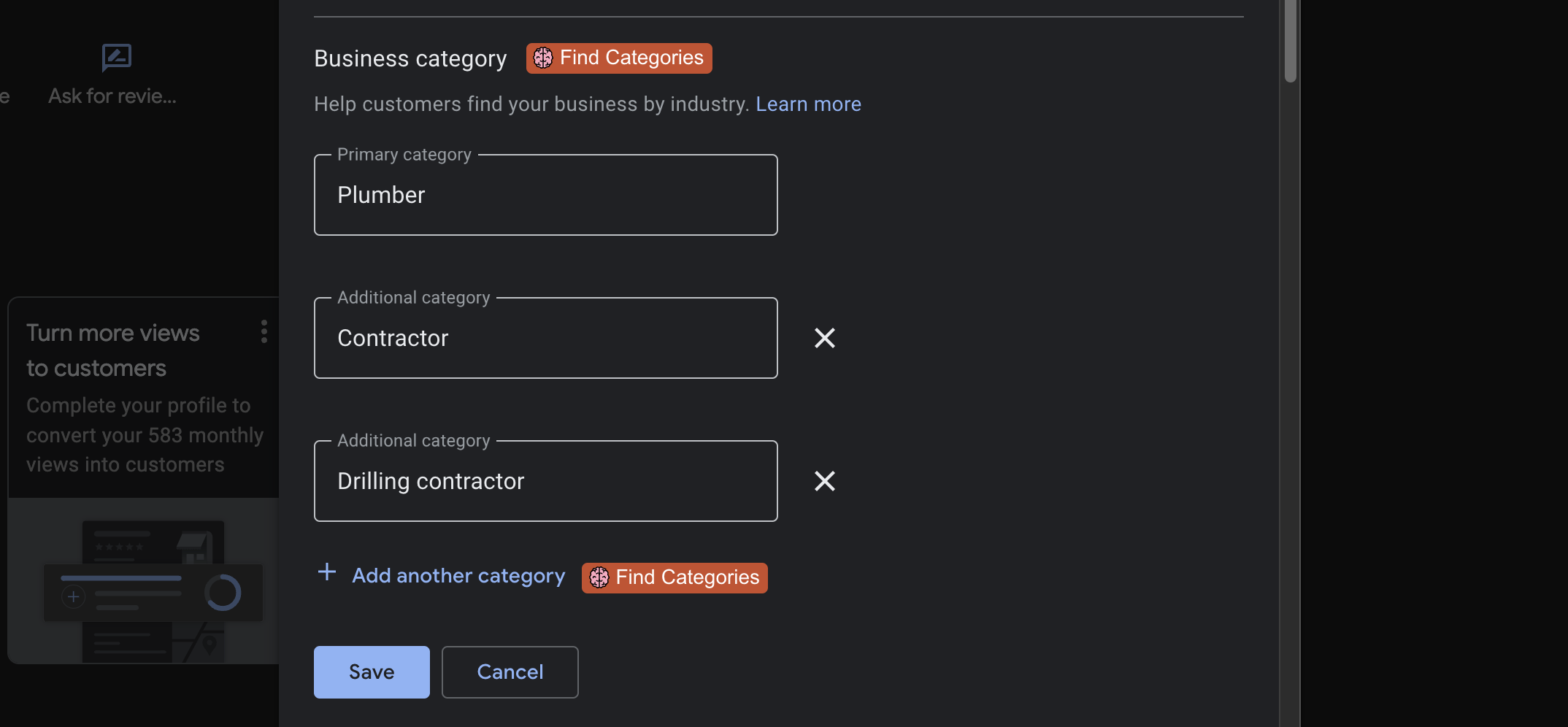Changing the primary category for your Google Business Profile is a crucial step for home-service businesses aiming to improve their local SEO and ensure they appear in the right search results. In the “How to Change the Primary Category for Your Google Business Profile” video, you learn a straightforward method to update your business category, which can significantly impact your online visibility. This comprehensive guide will walk you through the process in detail, offering additional insights and best practices to help you optimize your Google Business Profile effectively.
Why the Primary Category Matters
Selecting the correct primary category for your Google Business Profile (GBP) is essential because it directly influences how your business appears in search results. The primary category tells Google what your business does, helping it match your profile with relevant customer searches.
Impact on Local SEO
Your primary category plays a significant role in local search engine optimization (SEO). Google uses your selected category to understand your business better and to rank it appropriately in search results. An accurate primary category ensures that your business appears when potential customers search for the services you offer, increasing your chances of attracting more clients.
Relevance to Customer Searches
When customers search for specific services, Google prioritizes businesses that match their search intent. For example, if you run a plumbing company and your primary category is set to “Plumber,” your business is more likely to appear in search results when someone looks for plumbing services in your area. Conversely, an incorrect category can lead to missed opportunities and reduced visibility.
Enhancing User Experience
An accurate primary category improves the overall user experience by ensuring that customers find businesses that genuinely match their needs. This relevance not only attracts more customers but also increases the likelihood of positive interactions and reviews, further boosting your online reputation.
Step-by-Step Guide to Changing Your Primary Category
Changing your primary category in Google Business Profile is a simple process that can be completed in just a few minutes. Follow these steps to ensure your business is accurately categorized.
Step 1: Access Your Google Business Profile
- Sign In to Your GBP Account
- Go to Google Business Profile and click on “Manage now.”
- Sign in using the Gmail account associated with your business profile. Ensure you have administrative access to make changes.
- Select the Correct Business Profile
- If you manage multiple business profiles, choose the one you want to update from the list displayed.
Step 2: Navigate to the Business Category Section
- Open the Profile Dashboard
- Once signed in, you’ll be directed to your business’s dashboard. Here, you can manage various aspects of your profile, including information, photos, and reviews.
- Locate the “Edit Profile” Tab
- In the dashboard, find and click on the “Edit Profile” tab. This section allows you to edit your business details, including your categories.
Step 3: Edit Your Business Category
- Find the Category Section
- Within the “Edit Profile” tab, scroll down to the “Business category” section. This is where you can view and edit your current categories.
- Click the Pencil Icon
- Next to your primary category, click the pencil icon to edit it. This will open a dropdown menu with a list of available categories.
- Select the Appropriate Primary Category
- Type in the new category that best describes your business. For example, if you’re a plumbing supply store, you might select “Plumbing Supply Store” instead of just “Plumber.”
- Ensure that the selected category accurately reflects your primary service or product offering.
Step 4: Add Additional Categories (Optional)
- Choose Secondary Categories
- In addition to your primary category, you can add up to nine secondary categories. These should represent other services or products your business offers.
- For example, a plumbing company might add “Emergency Plumbing Services” or “Drain Cleaning” as secondary categories.
- Save Your Changes
- After selecting the appropriate categories, click “Apply” or “Save” to update your profile.
Step 5: Await Google’s Approval
- Submission for Review
- Once you’ve made the changes, Google will review your new primary category to ensure it aligns with their guidelines.
- This process typically takes a few days, but it can sometimes take longer depending on the volume of changes being processed.
- Monitor Your Profile
- Check your GBP periodically to see if the new category has been approved. You may receive notifications via email or within your GBP dashboard regarding the status of your update.
Best Practices for Selecting the Right Category
Choosing the right primary category is essential for maximizing your GBP’s effectiveness. Here are some best practices to help you make the best selection.
Be Specific and Accurate
- Choose the Most Relevant Category: Select a category that most accurately represents your primary business activity. Avoid overly broad categories that can dilute your profile’s relevance.
- Use Exact Terms: If Google offers a specific category that matches your business, use it. For example, “Plumbing Supply Store” is more precise than just “Plumber.”
Research Competitors
- Analyze Competitor Profiles: Look at how your competitors have categorized their businesses. This can give you insights into the most effective categories for your industry.
- Identify Gaps: Find categories that your competitors may have overlooked or underutilized, allowing your business to stand out.
Utilize Secondary Categories Wisely
- Complement Your Primary Category: Use secondary categories to highlight additional services or products without overshadowing your primary offering.
- Avoid Redundancy: Ensure that your secondary categories add unique value and do not repeat the primary category or each other.
Stay Updated with Industry Changes
- Adapt to New Services: If your business expands or introduces new services, update your categories accordingly to reflect these changes.
- Monitor Google’s Category List: Google periodically updates its category options. Stay informed about new categories that may better fit your evolving business needs.
Common Mistakes to Avoid
While updating your primary category is straightforward, avoiding common mistakes can help ensure the process goes smoothly and benefits your business.
Choosing Irrelevant Categories
- Misalignment with Services: Selecting a category that doesn’t accurately represent your services can confuse customers and harm your SEO efforts.
- Overly Broad Categories: Categories like “Home Services” may be too generic and fail to highlight your specific expertise.
Ignoring Category Hierarchy
- Primary vs. Secondary Categories: Understand the difference between primary and secondary categories. The primary category should represent your main service, while secondary categories can highlight additional offerings.
- Prioritizing Quantity Over Quality: It’s better to have a few relevant secondary categories than many irrelevant ones.
Failing to Update Categories
- Neglecting Business Changes: As your business evolves, so should your GBP categories. Regularly review and update your categories to reflect any changes in your services or target market.
- Ignoring Google’s Guidelines: Ensure that your selected categories comply with Google’s policies to avoid delays or rejections in approval.
Overcomplicating Categories
- Too Many Categories: Adding too many categories can dilute the focus of your profile. Stick to the most relevant and impactful categories.
- Complex Naming: Avoid using complicated or unclear names for your categories. Clear and straightforward terminology is more effective.
Maximizing the Benefits of the Correct Primary Category
Once you’ve updated your primary category, it’s essential to leverage this change to its fullest potential.
Optimize Your Business Description
- Align with Your Category: Ensure that your business description complements your primary category by highlighting relevant services and expertise.
- Incorporate Keywords: Use keywords related to your primary category naturally within your description to boost SEO.
Enhance Your Service Listings
- Detailed Service Pages: Link your GBP categories to detailed service pages on your website. This provides customers with more information and improves your site’s SEO.
- Consistent Branding: Ensure that your service pages reflect the same terminology and branding used in your GBP categories for consistency.
Encourage Customer Reviews
- Targeted Feedback: Encourage customers to leave reviews that mention the specific services represented by your primary category. This reinforces your expertise and improves credibility.
- Respond to Reviews: Actively respond to reviews to show engagement and build trust with potential customers.
Monitor Performance Metrics
- Track Visibility: Use Google Analytics and GBP insights to monitor how changes in your primary category affect your search rankings and visibility.
- Adjust Strategies: Based on performance data, make informed decisions about further optimizing your categories and overall GBP strategy.
Frequently Asked Questions
How Often Should I Review My Primary Category?
It’s advisable to review your primary category at least once a year or whenever your business undergoes significant changes in services or target market. Regular reviews ensure that your GBP remains accurate and effective.
Can I Change My Primary Category More Than Once?
Yes, you can change your primary category multiple times as needed. However, frequent changes can confuse customers and may affect your SEO performance. Make changes thoughtfully and ensure each new category accurately reflects your business.
What Happens If Google Disapproves My Category Change?
If Google disapproves your category change, they will notify you with the reason. Review their guidelines, ensure your chosen category aligns with your business services, and try submitting the change again with the necessary adjustments.
Should I Use Google’s Suggested Categories or Find My Own?
It’s best to use Google’s suggested categories as they are optimized for search relevance. However, if you find a more specific category that accurately represents your business, it’s acceptable to choose that instead.
How Do I Know If My Primary Category is Affecting My SEO?
Monitor your local search rankings and GBP insights to see how changes in your primary category impact your visibility. An improvement in search rankings and an increase in customer inquiries can indicate a positive effect on your SEO.
Common Mistakes to Avoid
Choosing Irrelevant Categories
Selecting a category that doesn’t accurately reflect your primary services can lead to confusion among potential customers and negatively impact your search rankings. For instance, a plumbing company choosing “General Contractor” instead of “Plumber” might miss out on highly targeted search traffic.
Overlooking Secondary Categories
While the primary category is crucial, neglecting secondary categories can limit your visibility. Secondary categories allow you to highlight additional services you offer, such as “Emergency Plumbing Services” or “Drain Cleaning,” which can attract a broader range of customers.
Ignoring Google’s Category Guidelines
Failing to adhere to Google’s guidelines when selecting categories can result in your changes being disapproved. Make sure your selected categories are compliant with Google’s policies and accurately represent your business activities.
Not Regularly Updating Your Profile
Businesses evolve, and so should your GBP. If you expand your services or pivot your business focus, update your primary category to reflect these changes. Keeping your profile outdated can lead to missed opportunities and decreased relevance in search results.
Best Practices for Managing Your Primary Category
Conduct Regular Audits
Regularly audit your GBP to ensure that all information, especially your primary category, remains accurate and up-to-date. This proactive approach helps you stay ahead of any changes in your business or industry trends.
Use Accurate and Descriptive Language
When selecting categories, use precise and descriptive terms that clearly communicate what your business offers. Avoid vague or overly broad categories that can dilute your profile’s focus and effectiveness.
Align with Your Website Content
Ensure that your GBP categories align with the content on your website. Consistency between your GBP and website helps reinforce your SEO efforts and provides a seamless experience for customers moving between platforms.
Leverage Customer Feedback
Pay attention to the language and terms your customers use in reviews and inquiries. Incorporating these keywords into your categories can improve relevance and boost your profile’s visibility in search results.
Optimize for Local Searches
Tailor your primary category to include local identifiers if applicable. For example, “Plumbing Services in Portland, Oregon” can help you rank better for location-specific searches, making it easier for local customers to find you.
Leveraging the Correct Primary Category for Competitive Advantage
Having the right primary category not only improves your visibility but also sets you apart from competitors. Here’s how to use it to your advantage:
Highlight Specialized Services
If your business offers specialized services, make sure your primary category reflects this specialization. This can attract customers looking for specific expertise, giving you an edge over more general competitors.
Showcase Unique Selling Points
Use your category to emphasize what makes your business unique. Whether it’s eco-friendly plumbing solutions or 24/7 emergency services, highlighting these aspects can attract a niche market and differentiate you from others.
Enhance Brand Authority
A well-chosen primary category can establish your business as an authority in your field. When customers see that you are categorized correctly and consistently, it builds trust and reinforces your reputation as a reliable service provider.
Integrating Primary Category Changes with Marketing Strategies
Update Marketing Materials
Ensure that all your marketing materials, both online and offline, reflect your updated primary category. This includes your website, social media profiles, business cards, and promotional flyers.
Inform Your Team
Make sure your team is aware of the category changes and understands how to communicate them to customers. Consistent messaging across all touchpoints enhances brand coherence and customer trust.
Utilize SEO Best Practices
Incorporate relevant keywords related to your primary category into your website’s content, meta descriptions, and headings. This alignment boosts your SEO efforts, making it easier for search engines to recognize and rank your business appropriately.
Monitor Competitor Categories
Stay informed about how your competitors categorize their businesses. This knowledge can help you refine your own category selection and identify opportunities to capture market share through more precise or comprehensive categorization.
Monitoring and Evaluating the Impact of Category Changes
Track Search Rankings
Use tools like Google Analytics and Google Search Console to monitor changes in your search rankings after updating your primary category. Look for improvements in visibility and increases in website traffic from local searches.
Analyze Customer Inquiries
Pay attention to any changes in the volume and type of customer inquiries you receive. An accurate primary category should lead to more relevant inquiries, reducing the time you spend addressing unrelated questions.
Gather Customer Feedback
Ask customers how they found your business and what terms they used to search for your services. This feedback can provide valuable insights into the effectiveness of your category selection and suggest further optimizations.
Adjust Based on Performance Data
Use the data collected from monitoring tools to make informed decisions about further category adjustments or other aspects of your GBP strategy. Continuous improvement ensures that your profile remains optimized for the best possible performance.
Frequently Asked Questions
Can I Change My Primary Category More Than Once?
Yes, you can change your primary category as often as needed. However, frequent changes can confuse customers and may disrupt your SEO efforts. It’s best to select the most accurate category initially and only make changes when there is a significant shift in your business operations or services.
How Long Does It Take for Category Changes to Reflect?
Once you submit a category change, Google typically reviews and approves it within a few days. However, the exact timeframe can vary based on the volume of changes being processed. Regularly check your GBP to see if the update has been applied.
What Should I Do If Google Disapproves My Category Change?
If your category change is disapproved, review Google’s guidelines to ensure compliance. Make sure the new category accurately represents your business and try submitting the change again with any necessary adjustments.
How Do I Choose the Best Category for My Business?
Research similar businesses and see how they categorize themselves. Use Google’s category suggestions as a starting point and choose the most specific and relevant category that accurately reflects your primary services.
Can I Add Multiple Primary Categories?
No, Google Business Profile allows only one primary category. However, you can add up to nine secondary categories to highlight additional services or aspects of your business.
Common Mistakes to Avoid
Selecting a Category Based on Trends
Choosing a category solely based on current trends without considering its relevance to your core services can lead to misalignment. Always prioritize accuracy over trendiness to ensure your profile attracts the right audience.
Ignoring Google’s Category Options
Sometimes, businesses overlook specific categories offered by Google that perfectly match their services. Take the time to explore all available categories to find the one that best fits your business.
Failing to Use Specific Terms
Using broad terms like “Home Services” instead of specific ones like “Plumbing Repair” can dilute your profile’s effectiveness. Specific terms improve search relevance and attract more targeted traffic.
Not Utilizing Secondary Categories
Secondary categories provide additional opportunities to showcase your services. Ignoring them means missing out on potential visibility for other services you offer.
Overcomplicating the Category Structure
While it’s important to be specific, overcomplicating your category structure with too many subcategories can confuse customers. Aim for a balanced approach that clearly represents your primary and secondary services.
Best Practices for Maintaining an Accurate Primary Category
Regularly Review Your Business Activities
Stay informed about any changes in your business operations or services. Regular reviews ensure that your GBP categories remain aligned with what your business currently offers.
Stay Updated with Google’s Category Changes
Google periodically updates its list of categories. Keep an eye on these changes to take advantage of new categories that may better represent your business.
Use Clear and Consistent Naming
When creating or selecting categories, use clear and consistent naming conventions. This helps both customers and search engines understand your services better.
Leverage Google’s Suggestions
When editing your categories, pay attention to Google’s category suggestions. These suggestions are optimized for search relevance and can help you make more informed decisions.
Train Your Team on GBP Management
Ensure that your team members who manage your GBP understand the importance of accurate categorization and know how to update categories when necessary. Consistent management helps maintain the integrity of your profile.
Integrating Category Changes with Overall Marketing Strategy
Align Categories with Marketing Goals
Ensure that your GBP categories support your broader marketing objectives. Whether you aim to highlight new services, target specific customer segments, or expand into new areas, your categories should reflect these goals.
Promote Your Updated Profile
Once you’ve updated your primary category, promote your GBP across your marketing channels. Inform your customers through email newsletters, social media posts, and your website to increase visibility and drive more traffic to your profile.
Use Categories to Inform Content Strategy
Your GBP categories can guide your content marketing strategy. Create blog posts, social media content, and other marketing materials that align with your primary and secondary categories to reinforce your expertise and attract targeted traffic.
Monitor Competitor Strategies
Keep an eye on how your competitors categorize their businesses. Understanding their strategies can provide insights into optimizing your own categories and identifying areas for improvement.
Optimize for Seasonal and Local Trends
Adjust your categories to reflect seasonal trends or local events that may influence customer needs. For example, adding “Winter Plumbing Services” during colder months can attract customers seeking specific solutions.
Final Thoughts
Changing the primary category for your Google Business Profile is a powerful way to enhance your online presence and improve your local SEO. By selecting the most accurate and relevant category, you ensure that your business appears in the right search results, attracts the right customers, and stands out from competitors. Follow the step-by-step guide provided in this post, adhere to best practices, and avoid common mistakes to maximize the benefits of your GBP category updates. Regularly reviewing and optimizing your categories will keep your profile aligned with your business goals, ensuring sustained growth and success in the competitive home-service market.




